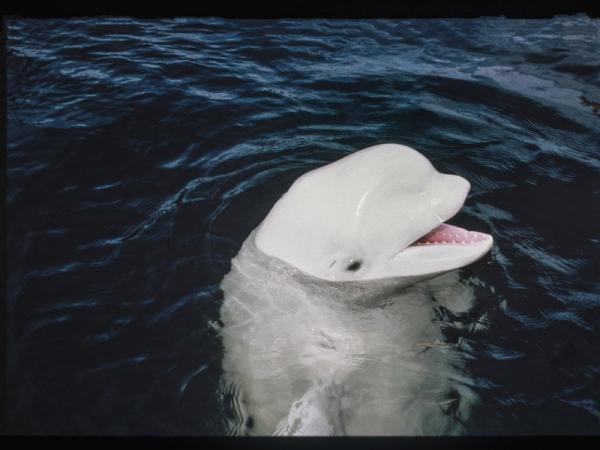The Story of One Whale Who Tried to Bridge the Linguistic Divide Between Animals and Humans

While captive in a Navy program, a beluga whale named Noc began to mimic human speech. What was behind his attempt to talk to us?
Millions of years before we humans came along, the earth’s oceans were a vast, unbroken web of whale song. The complex courting arias of humpbacks, the distinct clicking dialects of migrating sperm-whale clans, the congalike poundings of Pacific grays, the multi-thousand-mile moans and blips of massive blue and fin whales conversing across oceans at octaves well below our range of hearing, the nearly nonstop Arctic chatter of belugas: All of them are being drowned out now by our clamor.
And yet a single beluga managed to make his voice go global again, and in the only medium left him: the worldwide web. The extraordinary history of Noc (pronounced no-see) resurrects a captive who somehow has found a way to speak to us, both literally and figuratively, of the true nature of his kind.
Since the early 1960s the United States had been deploying marine mammals, beginning with dolphins, for tasks including mine detection and recovery of test torpedoes. By the mid-1970s, the locus of the naval cold war had shifted to the Arctic, where the latest Soviet submarines were secreting themselves under the ice cap, an environment off-limits to animals including dolphins and sea lions used in the Navy Marine Mammal Program (NMMP). Experiments commenced on weaponry that could function in such extreme conditions. The Navy needed marine mammals with built-in sonar, capable of locating and retrieving sunken experimental torpedoes in the frigid waters and low visibility of the Arctic.
In August 1977, with Canadian government consent, Sam Ridgway, a Texas-born veterinarian and a co-founder of NMMP, dispatched a team to the northern coast of Manitoba. There, the Navy would procure the first belugas for a new Arctic initiative, known as “Cold Ops.” Belugas typically travel in pods of approximately 25 whales, led by a dominant male but bound by close ties between mothers and their calves. Newborns nurse for about two years and, living within a multitiered matriarchal society very similar to that of elephants, are also raised by an extended group of females.
Belugas make for obliging quarry, their affable, curious natures often leading them directly up to divers and boats. As for the vessel Ridgway had deployed that summer 37 years ago, it also contained two Inuit hunters hired to expedite the recruitment process. When a beluga approached their boat, one hunter would jump on the whale’s back and slip a lasso around its neck, like a high plains mustang. The other would then slide a floating stretcher under the whale and lead it ashore. Once there it was placed in a leak-proof crate containing a few centimeters of water and loaded onto a transport jet for immediate transfer to a netted underwater enclosure at the Navy’s Space and Naval Warfare Systems Center, off Point Loma, California.
Six belugas were caught between 1977 and 1980. Among them was the 2-year-old male calf named Noc, after the tiny biting summer flies known as no-see-ums. The youngest of the Cold Op’s recruits, Noc lived virtually his entire life in captivity, working side by side with human trainers. He ended up being deployed for two top-secret Navy surveillance and retrieval programs before succumbing to meningitis in 1999 at the age of 23 while still in the Navy’s care.
Then Noc suddenly re-emerged in the form of a 20-odd-second recording, included as a mere supplement to a research paper by Ridgway, “Spontaneous Human Speech Mimicry by a Cetacean,” in the October 23, 2012, edition of the journal Current Biology.
Within days Noc’s voice was burbling from computers around the globe. He sounds, on first hearing, at least, less like a person talking than a delirious drunk humming an atonal tune through a tissue-covered comb. A goofy quotient only heightened by the photo of Noc that ran with most of the breaking news stories about him: his duck-billed and dumbstruck mouth; his deep-set, frontally fixed eyes. But the science behind Noc’s mimicry and its apparent motives reveals something far more urgent and haunting: the spectral outpourings of a young white whale calling to us across both time and the vast linguistic divide between humans and the other animals.
Оставить комментарий
Для комментирования необходимо войти через ![]() Вконтакте
Вконтакте
